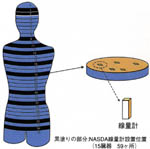|
|||||
 |
 |
| Human Body Phantom | International Cooperation |
|
|
One of the experiments NASDA will conduct on STS-91 involves a device called
the Human Body Phantom. We interviewed Mr. Komiyama of the Medical Research
and Operations Office of NASDA, who is responsible for this experiment.
 |
| Human Body Phantom |
Q1. First of all, what is the Human Body Phantom?
A1. In short it is a mannequin to monitor radiation effect inside
the human body. It simulates the human body except the arms and legs. It
is made of plastic which is equivalent to the human body in terms of reaction
to radiation (average atomic number or atomic density). It is composed
of 35 plastic plates stacked up to shape the human body. Each plate has
holes where dosimeters can be inserted to monitor radiation of the location
corresponding to internal organs to be investigated. After dosimeters are
inserted, the parts are put into bags made of nonflammable cloth to simulate
clothing. On orbit, these parts are assembled to shape the human body and
will be set inside Space Shuttle. After landing, the dosimeters will be
evaluated to analyze radiation effects on human parts.
Q2. What is the weight and size of Human Body Phantom?
A2. It weighs 96lb, and its sizes are 40in height, 16in width, 9in
thickness. Sex and ages are not considered.
Q3. What kind of experiments are you planning to conduct using this
Human Body Phantom?
A3. NASDA will insert 59 dosimeters to locations corresponding to
fifteen internal organs to monitor radiation effects to each of them.
Q4. What are those fifteen organs?
A4. They are the brain, thyroid gland, esophagus, lung, heart, stomach,
liver, bone marrow, spinal column, bone surface, rectum, bladder, gonad,
skin of chest and skin of abdomen.
Q5. Why do we need to conduct this experiment?
A5. The construction of the International Space Station (ISS) will
start from late this year. When it is completed, a maximum of seven astronauts
including Japanese astronauts will be staying there constantly. Since the
duration of one inclement will be as long as several months, the effects
of microgravity or space radiation environment can not be ignored. As one
of the themes for astronaut health management, NASDA is currently studying
countermeasures for space radiation effects. This experiment aboard STS-91
is intended for the development of technology to accurately monitor the
space radiation effects, as well as to accumulate basic data for space
radiation.
 |
| Structure of Human Body Phantom |
Q6. How is NASDA and NASA cooperating for this experiment?
A6. NASA developed the Human Body Phantom, and NASDA provides 59
dosimeters into this device. NASA also inserts 400 dosimeters for their
experiments. We will cooperate in data analysis by exchanging the data
acquired through this experiment.
Q7. NASA inserts as much as 400 dosimeters whereas NASDA uses only 59.
Is there a particular reason for this difference?
A7. NASDA's dosimeter is composed of nine kinds of materials which
allows us to acquire many kinds of data from one dosimeter. NASDA is interested
in monitoring radiation data of internal organs. On the other hand, NASA
dosimeter is made of one kind of material which brings about specific data.
NASA uses as many dosimeters as possible to acquire radiation effect over
total human body without concentrating to particular internal organs.
Q8. Where in the Space Shuttle will this Human Body Phantom be located?
A8. In the Spacehab which is located in the cargo bay of the Space
Shuttle. It will be bound to one of the racks in the Spacehab. If it is
floating in the Spacehab, it might simulate the astronauts' movements in
space much better, but this is not allowed because it will disturb the
crew members' activities. On the other hand, since it is fixed in the vicinity
of other radiation monitoring devices of NASA, this situation allows researchers
to compare data of each other with ease.
 |
| Mr. Komiyama |
Q9. What kind of Space Radiation countermeasures are considered now?
A9. We are planning to manage the radiation effects so that the
radiation risk of astronauts throughout their life time will be equal to
that of people who are engaged in radiation related occupation. When heavy
radiation is expected due to solar flare, astronauts aboard the ISS will
evacuate to an area in ISS where least radiation is estimated, and in the
worst case they will come back to the earth by the Crew Return Vehicle
(CRV). The most suitable evacuation area in the ISS is being examined.
Mr. Komiyama was very busy preparing for the STS-91 mission. He has just
returned from NASA Johnson Space Center in Houston, and is scheduled to
go back shortly. He was very friendly, and explained this difficult scientific
experiment in simple terms. We would like to express our appreciation his
sharing his time and answering our questions.
Last Updated : June 2, 1998
| Human Body Phantom | International Cooperation |

|